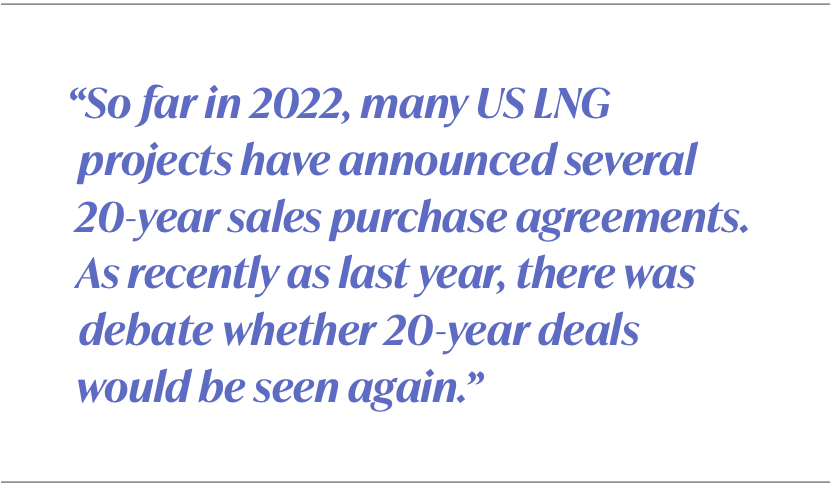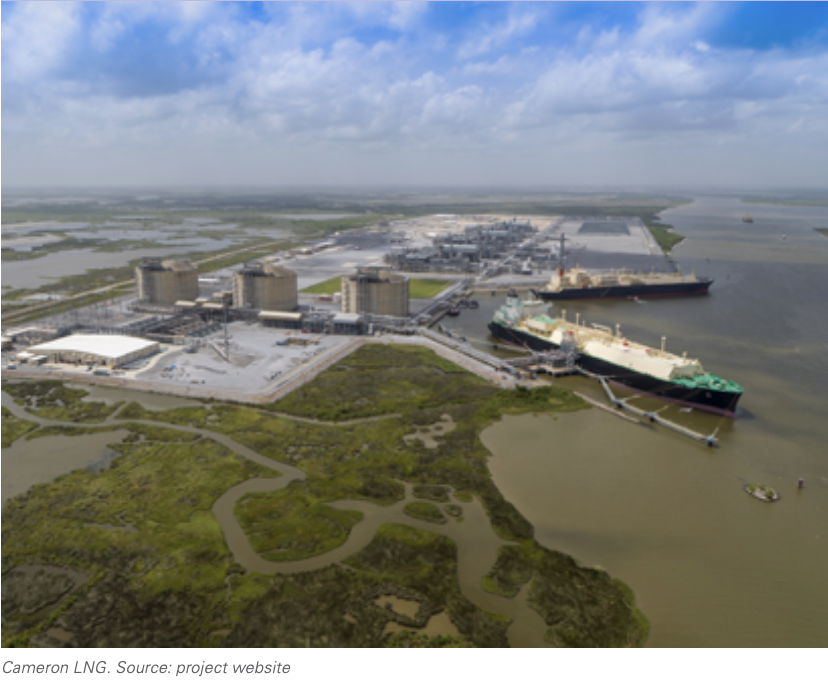Exploring the LNG outlook with Sempra Infrastructure CEO Justin Bird [Gas in Transition]
When does Sempra anticipate market conditions to return to something more typical of recent years prior to the pandemic?
Our fundamental long-term view for continued robust growth in LNG trade has not changed. We are strong believers that LNG from North America will be a critical component to meeting the world’s energy demand for decades, displacing higher greenhouse gas emitting fuels and complementing renewable generation resources.
The spot LNG market remains very strong, with prices oscillating in the $20-$30 range, and we are also seeing more long-term contracts in the global market. Long-term procurement was very strong in 2021 and 2022 is on track to be very strong as well.
Overall, our development projects are well positioned to capture the continuing growth in LNG demand, and you should expect us to continue to grow our market share with buyers.
The pandemic of course made prior forecasts for demand obsolete. But similarly those forecasts made during the pandemic, predicting a tight market not to emerge until the mid-2020s, have also been shown to be wildly inaccurate. How can LNG producers today make sound investments in such volatility?
 We are seeing more long-term LNG contracts in the global market. Long-term procurement from China reached an all-time peak last year and over the long run, we continue to see demand for LNG growing mid to high single digits, which supports US LNG exports and our portfolio of projects. So far in 2022, many US LNG projects have announced several 20-year sales purchase agreements. As recently as last year, there was debate whether 20-year deals would be seen again. In order for new supply to come online, investments will have to be made in the form of long-term sales purchase agreements.
We are seeing more long-term LNG contracts in the global market. Long-term procurement from China reached an all-time peak last year and over the long run, we continue to see demand for LNG growing mid to high single digits, which supports US LNG exports and our portfolio of projects. So far in 2022, many US LNG projects have announced several 20-year sales purchase agreements. As recently as last year, there was debate whether 20-year deals would be seen again. In order for new supply to come online, investments will have to be made in the form of long-term sales purchase agreements.
Do you see supply contracts burdened by destination restrictions as becoming a thing of the past considering the market’s current tightness, which has led to a lot of cargo diversion?
From a US perspective, destination restrictions have never been considered. All projects in the US have complete destination flexibility consistent with US trade laws. As for non-US projects, it looks like destination restrictions are less common. From what we have seen, nearly all of the new contracts signed recently have no destination restrictions.
What more needs to be done by the LNG sector to ensure sustainability? What can Sempra say about the outlook for carbon-neutral certified LNG and recent initiatives such as that proposed by GIIGNL and others to increase transparency and uniformity in the certification process?
US LNG is already contributing to lowering global emissions by displacing more carbon-intensive fuel sources, especially in developing markets in search of reliable energy. Efficient decarbonisation of the LNG value chain will be key to enhancing the climate benefits of an expanded use of natural gas.
As demonstrated by the experience of the US power sector over the past several decades, natural gas paired with an expansion of renewable energy is one of the most effective means of achieving large GHG reductions quickly. We also believe industry and governments must work together on developing the next generation technologies like carbon capture and sequestration and zero-emitting fuels like clean hydrogen.
We are excited to be part of the GIIGNL framework that can provide a common source of best practices in monitoring, reporting, reduction, offsetting and verification of GHG emissions associated with a delivered cargo of LNG. As we have said in the past, the tools and pathways provided within the framework will help LNG organisations create clear and reliable GHG emissions reporting that can be independently verified, supporting them to make good on their climate commitments.
What is Sempra doing to address emissions directly under its control and also those indirect ones relating to its suppliers?
Sempra Infrastructure continues to build a strong business portfolio and is working on a number of initiatives focused on sustainability and the global energy transition to advance our goal to lower GHG emission intensity at our LNG facilities while working to provide decarbonisation solutions to our customers here in North American and global energy markets. We are advancing opportunities in renewables, hydrogen, ammonia, LNG and carbon capture infrastructure.
Recently, the company announced the expansion of North America’s first cross-border wind generation facility, Energia Sierra Juarez; a non-binding memorandum of understanding with Entergy to pursue renewable energy sources to power Sempra Infrastructure facilities in Louisiana; and, working with our joint partners, we filed an amendment with FERC in order to optimise the design of the Cameron LNG expansion project which will allow us to build a cost-effective and more efficient facility, while also advancing new technological solutions that will lower greenhouse gas emissions.
We are also developing the Hackberry Carbon Sequestration project in Louisiana, a planned three-injection wells facility with an expected potential sequestration capacity of up to 4.5mn metric tons/year of CO2. HCCS will be designed to receive and store CO2 from multiple sources, potentially including LNG terminals and other industrial sources along the Gulf Coast.
Additionally, last year we partnered with BP to deliver our first carbon offset LNG cargo import into the Energia Costa Azul terminal in Mexico. Global demand for natural gas and LNG is expected to continue to grow and we will continue supporting this growth by diversifying their offerings, including developing bundled carbon offset LNG products to help meet customers' demand.
.png)
Sempra, our parent company, is a sponsor of the Veritas initiative, led by the Gas Technology Institute, to develop methane measurement and reconciliation protocols for the natural gas value chain to facilitate reductions and better quantification of methane emissions from upstream production through liquefaction. Sempra Infrastructure will be performing demonstration projects of the protocols for the LNG segment of the Veritas initiative.
There are clear logistical advantages to exporting US gas to Asia via Mexico. Could you illustrate this in numbers like freight cost?
West Coast location provides pacific basin buyers a unique competitively differentiated alternative to US Gulf Coast supply given the avoidance of the Panama Canal, shipping optimization to Asian markets and extrinsic value of West Coast position.
For example, once completed, our ECA LNG Phase 1 project under construction on the West Coast of Mexico, is expected to provide customers with a competitive advantage in accessing world markets, especially Asia, in half the time. This means, U.S. natural gas could reach Asian markets in approx. 11 days instead of 21 days. Depending on shipping economics, the reduction in time provides significant cost savings as shipping cost accounts for approximately 20% of total delivered cost of LNG.
Though at the same time, there are challenges such as Mexico’s propensity for resource nationalisation, and other challenges in working in the country. Can you elaborate?
We believe in the long-term fundamentals of the Mexican market, and we will continue to be focused on developing energy infrastructure to meet the country’s growing energy demands.
Our management team in Mexico City has a strong track record of navigating the evolving political landscape in Mexico, and we believe Mexico will still need private investment along with the public budget to develop new infrastructure that helps secure their growing energy needs.
We continue to work with Mexico’s administration on projects and ways to partner. For example, earlier this year, we signed an MoU with Mexico’s state-owned utility, CFE, for the potential development of important energy projects in the country, including Vista Pacífico LNG, a natural gas liquefaction project in Topolobampo, Sinaloa, and a natural gas regasification project in La Paz, Baja California Sur.
The development of these projects would allow CFE to optimise excess natural gas and pipeline capacity from Texas to Topolobampo in order to increase its natural gas supply to its power plants in Baja California Sur, to advance President Andres Manuel Lopez Obrador’s commitment to supply the state with low-cost electricity and lower-emission fuels, and to promote economic growth and development of the region, with a view toward strengthening CFE’s position in global LNG markets.
Describe the road between now and an FID at Vista Pacifico, and when are you hoping to reach a project sanction?
Our Vista Pacifico LNG project in Northern Mexico is in the early stages of development. The team has completed an initial early-stage gas supply, environmental, social, and technical pre-feasibility analysis and initiated engineering and permitting activities in 2020.
On April 9, 2021, DoE issued the FTA authorisations and we have filed the application seeking FTA and Non-FTA export authorisation from the DoE for up to 4 Mtpa.
The project team is advancing development activities and working with stakeholders in support of the project, and we are currently in discussion with potential customers on the commercial structure. Any commercial structure will be structured to offer Sempra Infrastructure a T&D-like risk profile, similar to our other infrastructure businesses.
Just last month, we announced Sempra Infrastructure and TotalEnergies are expanding their North American strategic alliance through a memorandum of understanding for the proposed Vista Pacífico LNG project. The MoU contemplates TotalEnergies contracting for approximately one-third of the long-term export production of the LNG facility, as well as TotalEnergies’ potential participation as a minority equity investor in the project.
The timing of a final investment decision will be subject to the receipt of all necessary permits, finalising commercial arrangement, and executing a definitive EPC contract.
Was the recent decision to downsize Cameron LNG only about emissions considerations? Were there any strictly commercial factors?
The Cameron LNG FERC amendment filing looks to optimise the design of the expansion project. As we do with all of our facilities, we are continuously examining the potential for efficient design enhancements that will further reduce emissions, such as electrifying key equipment and powering them with renewable energy and exploring the use of carbon capture and sequestration. We believe these changes will allow us to build a cost-effective and more efficient facility, while also advancing new technological solutions that will lower greenhouse gas emissions.
 As you saw in the filing, some of the key proposed enhancements to the already permitted expansion project include:
As you saw in the filing, some of the key proposed enhancements to the already permitted expansion project include:
- Resizing the Phase 2 expansion to a single 6.75mn mt/yr Train 4 in lieu of the previously authorised Trains 4 and 5.
- Utilising electric drive (E-drive) motors in lieu of gas turbine drives.
- Tie-in facilities that provide a connection to potential future projects to allow the sequestration of carbon dioxide from the Train 4 acid gas removal unit.
- Reducing the total direct onsite CO2e emissions from Train 4 by approximately 44% compared to the existing authorised design for the project.



